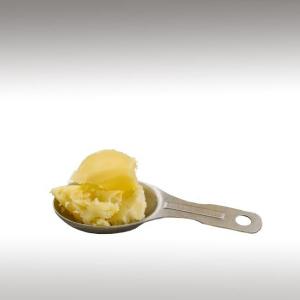
GHEE (CLARIFIED BUTTER) - INGREDIENTS

BASE / GENERAL DATA
Information submited: June 16, 2015 Modified: May 30, 2018 By: OperaDreamhouse
Ghee is a class of Clarified Butter that originated in ancient India and is commonly used in South Asian and Iranian cuisines, traditionalmedicine, and religious rituals.
Clarified Butter is milk fat rendered from Butter to separate the milk solids and water from the butterfat. Typically, it is produced by melting Butter and allowing the components to separate by density. The Water evaporates, some solids float to the surface and are skimmed off, and the remainder of the milk solids sink to the bottom and are left behind when the butter fat (which would then be on top) is poured off.
Traditionally, Ghee (Go-Ghṛta) is always made from the milk of cows, which are considered sacred, and it is a sacred requirement in Vedic Yajña and Homa (Fire Sacrifices), through the medium of Agni (Fire) to offer oblations to various deities.
The production of Ghee includes simmering the Butter along with the milk solids so that they caramelize, which makes it nutty - tasting and aromatic.
Ghee is prepared by simmering butter, which is churned from cream, and removing the liquid residue. Spices can be added for flavor. The texture, color, and taste of Ghee depend on the quality of the Butter, source of the milk used in the process and the duration of the boiling.
According to Ayurveda, Ghee is traditionally made in a way rather different than clarified butter. To make real ghee, one must obtain raw milk, then boil it, let it cool to 43 °C, and add Curd (Indian Yogurt) cultures. After letting it set, covered at room temperature for around 12 hours, the curd is then churned using ancient methods to obtain this specific type of cultured Butter. This Butter is finally used to simmer into Ghee.
Chemical structure:
Like any clarified butter, ghee is composed almost entirely of fat, 62% of which consists of saturated fats.
Fats and fatty acids per 100 g of ghee:
Total fat - 99,5 g
Saturated fat - 61,9 g
Monounsaturated fat - 28,7 g
Polyunsaturated fat - 3,7 g
Trans fats - 4 g
Omega-3 fatty acids - 1447 mg
Omega-6 fatty acids - 2247 mg
Non-fat nutrients per 100 g of ghee:
Cholesterol - 256 mg (85%DV)
Vitamin A - 3069 IU (61% DV)
Vitamin E - 2,8 mg
Vitamin K - 8,6 µg
Clarified Butter is milk fat rendered from Butter to separate the milk solids and water from the butterfat. Typically, it is produced by melting Butter and allowing the components to separate by density. The Water evaporates, some solids float to the surface and are skimmed off, and the remainder of the milk solids sink to the bottom and are left behind when the butter fat (which would then be on top) is poured off.
Traditionally, Ghee (Go-Ghṛta) is always made from the milk of cows, which are considered sacred, and it is a sacred requirement in Vedic Yajña and Homa (Fire Sacrifices), through the medium of Agni (Fire) to offer oblations to various deities.
The production of Ghee includes simmering the Butter along with the milk solids so that they caramelize, which makes it nutty - tasting and aromatic.
Ghee is prepared by simmering butter, which is churned from cream, and removing the liquid residue. Spices can be added for flavor. The texture, color, and taste of Ghee depend on the quality of the Butter, source of the milk used in the process and the duration of the boiling.
According to Ayurveda, Ghee is traditionally made in a way rather different than clarified butter. To make real ghee, one must obtain raw milk, then boil it, let it cool to 43 °C, and add Curd (Indian Yogurt) cultures. After letting it set, covered at room temperature for around 12 hours, the curd is then churned using ancient methods to obtain this specific type of cultured Butter. This Butter is finally used to simmer into Ghee.
Chemical structure:
Like any clarified butter, ghee is composed almost entirely of fat, 62% of which consists of saturated fats.
Fats and fatty acids per 100 g of ghee:
Total fat - 99,5 g
Saturated fat - 61,9 g
Monounsaturated fat - 28,7 g
Polyunsaturated fat - 3,7 g
Trans fats - 4 g
Omega-3 fatty acids - 1447 mg
Omega-6 fatty acids - 2247 mg
Non-fat nutrients per 100 g of ghee:
Cholesterol - 256 mg (85%DV)
Vitamin A - 3069 IU (61% DV)
Vitamin E - 2,8 mg
Vitamin K - 8,6 µg

SPIRITUAL PRACTISES DATA

MEDICINE / HEALTH DATA

BEAUTY / COSMETICS DATA

FOOD / COOKING DATA
COMMENTS
No comments.


